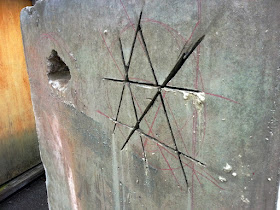Brentwood Fire and Rescue has
been spending time lately training on Urban Search and Rescue (USAR) and
building collapse. Recently department members spent time practicing breaching
thick concrete walls. Before dedicating time and resources to making a hole
large enough for a person to fit through, an inspection hole is cut. This
ensures that firefighters know what is on the other side of a wall, as well as
whether or not a wall can or should be breached. One of the best tools
available for this task is the K12, or Rotary Saw.
Brentwood Fire and Rescue has a Rotary Saw that is capable of accepting
a hose. This reduces the concrete dust in the air, which can be hazardous to
both rescuers and victims alike as well as creating visibility difficulties.
What looks like dust in this photo is actually mud being slung to the ground. The
hose is a typical garden hose like you probably have at home, and firefighters
can connect it to the fire engine to provide water at the scene.
Firefighters need to be able to make cuts in a variety of positions.
The wall has been marked with a pattern of overlapping triangles which allows
for intersecting cuts that will more quickly create an opening.
This saw is also equipped with a roller, allowing it to roll across the
wall, making it somewhat easier to manage while cutting.
Unfortunately, the wall is thicker than what the saw is able to cut.
Once the blade is buried to the hub on the last triangle, it’s time to switch
tools.
The next tool in the arsenal for this task is a rotary drill with an
impact setting. Firefighters can use this to chisel out the pattern they have
cut into the wall.
If a dirty saw is a happy saw, this tool must be ecstatic! Firefighters
will need to inspect and clean this saw after training concludes. The mud from
the concrete dust and water finds its way into every crevice on the tool and
can interfere with operating it later.
A close up view of the overlapping triangles firefighters have sawn
into this concrete wall.
The hammer drill and chisel bit make quick work of the pattern
firefighters have been cutting into the wall. Rock chips fly and chunks of the
wall quickly crumble away.
The finished inspection hole.
If this were an actual emergency,
firefighters could now check for hazards or victims on the other side of the
wall. They could monitor the air in the void space and pump in fresh air if
needed. This hole can also be expanded to allow access to the space for further
search and rescue operations.








